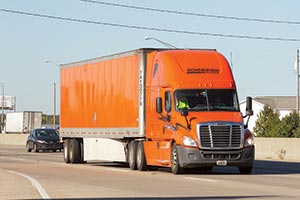Schneider Files to Go Public; Family, Execs to Keep Control

This story appears in the Jan. 2 print edition of Transport Topics.
Truckload and intermodal carrier Schneider National Inc., No. 7 on the Transport Topics Top 100 list of the largest U.S. and Canadian for-hire carriers, filed financial documents with the Securities and Exchange Commission on Dec. 22 as a prelude to the company going public, possibly later this year.
The registration said the company would offer a minority stake, leaving the Schneider family and top executives with the bulk of the voting power. Schneider asked the SEC to issue up to 600 million class B shares, to be listed on the New York Stock Exchange as SNDR.
None of the 250 million class A shares would be offered to the public, nor will all of the class B shares. Each class A share will get 10 votes, compared with one vote for each class B share, according to the S-1 filing.
“The dual class structure of our common stock has the effect of concentrating voting control with the Schneider family and the trustees under the Schneider National Inc. Voting Trust, and limiting your ability to influence corporate matters. Their interests may conflict with yours in the future,” the company listed as an assumed risk.
Noël Perry, an industry consultant at the FTR research firm and former corporate economist at Schneider, said he thinks the family wants liquidity and that CEO Christopher Lofgren would like additional capital to fund new ventures. Lofgren, 57, has run the company since 2002, when he succeeded Donald Schneider.
“They’ve basically done what they wanted to do since Don got sick, and that will continue. They’ve gotten it right and executed well against plenty of competition. It’s a well-managed company,” Perry said.
Schneider declined to comment beyond the contents of more than 200 pages filed with the SEC. The company’s major operating divisions are truckload, intermodal and logistics.
The filing gives the public a first glance into the financial health of the Green Bay, Wisconsin-based carrier founded in 1935 by Al Schneider. The company generated $109.1 million in net income during the first nine months of 2016, up 17% from the same period in 2015. Nine-month revenue was $2.98 billion, up 1.5% from the year prior.
Earnings before interest, taxes, depreciation and amortization, or EBITDA, were about $398 million for the first nine months of this year, up from $346 million the same period in 2015. EBITDA is considered an important measurement for investment bankers when determining how much money the company is worth.
Operating ratio, or expenses as a percentage of revenue, was 93.2 for the corporation and 89.8 for the truckload segment through Sept. 30.
“The trend lines in operating ratio are heading in the right direction,” said Burke Smith, managing director at investment bank Headwaters MB. “Their fleet size has gone up, year-over-year, while others are paring down, and they’ve held on revenue. They’re betting growing the fleet is the right thing to do strategically, whereas you see Swift [Transportation Co.] talking about cutting 500 trucks, year-over-year.”
“Swift is the cleanest comparable [stock] because J.B. Hunt [Transport Services] is skewed much more toward intermodal, and Schneider generates more revenue than Werner [Enterprises] and Knight [Transportation],” said Art Hatfield, a veteran transportation analyst.
Schneider recorded $349.5 million in capital expenditures through the third quarter, excluding the $78.2 million purchase of Watkins & Shepard Trucking and Lodeso Inc. in June, to enhance its e-commerce service for difficult-to-handle goods.
On the balance sheet, Schneider has a debt-to-equity ratio of 0.58 as of Sept. 30, meaning 58 cents of debt for each dollar of equity, or net worth.
Peter Kern, a partner at accounting firm BKD, said the SEC could take three to six months to approve the document, so the company would not be able to go public until the second or early third quarter of 2017.
“Schneider is going to get a good feel for the impact of the [electronic logging device] mandate with a late 2Q or early 3Q offering; the timing is very good for them,” Hatfield said.
Morgan Stanley, UBS Investment Bank and Bank of America’s Merrill Lynch are among Schneider’s investment bankers, authorized to buy and sell the initial shares to their clients.

